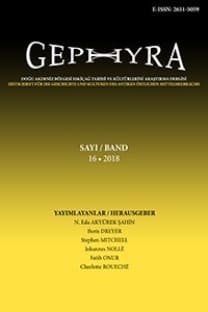Karyalıların İsimlerine Dair Notlar
Karyalılar için kullanılmış olan Eski Pers ismi Kr̥ka’nın Hitit kaynaklarında bahsedilen Kar(a)kiša ve Karkiya ülkeleri ile hiçbir ilgisi yoktur. Eski Persçe olan *kr̥ka “horoz” anlamına gelmektedir. Karyalılar miğferlerinde bulunan sorguçtan dolayı (Ploutarkhos), ama belki de farklı dillerde belgelenen ve -ka- kısmı olmayan benzer isimleri dolayısıyla böyle adlandırılmaktaydı.
Anahtar Kelimeler:
Karkiša, Karkiya, Eski Persçe, Ploutarkhos, takma adlar, Karyalılar
Remarks on the name of the Carians
Kr̥ka-, the Old Persian name for the Carians, has nothing to do with Kar(a)kiša and Karkiya, countries mentioned in Hittite sources. The meaning of Old Persian *kr̥ka- is ‘rooster’, and the Carians were called so because of the crest on their helmets (Plutarch), but probably also because of their similar name, attested without -ka- in other languages.
___
- I. J. Adiego, The Carian Language (Handbuch der Orientalistik 86), Leiden-Boston 2007.
- O. Carruba, Der Name der Karer, Athenaeum 88, 2000, 49-57.
- C. Binder, Plutarchs Vita des Artaxerxes. Ein historischer Kommentar, Berlin-New York 2008.
- M. de Vaan, The Indo-Iranian Animal Suffix *-ĀĆÁ-, Indo-Iranian Journal 43, 2000, 279-293.
- A. Dupont-Sommer, L’inscription araméenne, in: H. Metzger et al. (eds.), La stèle trilingue du Létôon (Fouilles de Xanthos VI), Paris 1979, 129-162.
- P. Kretschmer, Alakšanduš, König von Viluša, Glotta 13, 1924, 205-213.
- C. J. Martin, Demotic Papyri from the Memphite Necropolis (P. Dem. Memphis) in the Collections of the National Museum of Antiquities in Leiden, the British Museum and the Hermitage Museum, Turnhout 2009.
- C. J. Martin, A Persian Estate in Egypt: Early Demotic Papyri in the British Museum, in: F. Naether (ed.), Proceedings of the 13th International Congress for Demotic Studies, Leipzig, 4-8th September 2017 (ZÄS Beiheft). Berlin-Boston (im Druck).
- O. Masson, Le nom des Cariens dans quelques langues de l’antiquité, in: F. Bader (ed.), Melanges linguistiques offerts à Émile Benveniste (Coll. Ling. publiée par la Soc. de Ling. de Paris 70), Louvain 1975, 407-414.
- R. Oreshko, Geography of the Western Fringes: Gar(a)giša/Gargiya and the Lands of the Late Bronze Age Caria, (im Druck).
- J. D. Ray, Aegypto-Carica, Kadmos 37, 1998, 125-136.
- E. Rieken, Das Zeichen
im Hieroglyphen-Luwischen, in: A. Süel (ed.), VII. Uluslararası Hititoloji Kongresi Bildirileri Çorum 25-31 Ağustos 2008 / Acts of the VIIth International Congress of Hittitology Çorum, August 25-31, 2008, Vol. II. Ankara 2010, 651-660. - R. Schmitt, Wörterbuch der altpersischen Königsinschriften, Wiesbaden 2014.
- Zs. Simon, Against the identification of Karkiša with Carians, in: N. Chr. Stampolidis – Ç. Maner – K. Kopanias (eds.), Nostoi. Indigenous Culture, Migration + Integration in the Aegean Islands + Western Anatolia During the Late Bronze + Early Iron Ages, Istanbul 2015, 791-809.
- J. Tavernier, Iranica in the Achaemenid Period (ca. 550-330 B. C.). Lexicon of Old Iranian Proper Names and Loanwords, Attested in Non-Iranian Texts (Orientalia Lovanensia Analecta 158), Leuven-Paris-Dudley 2007, MA.
- G. Vittmann, Ägyptisch-Karisches, Kadmos 40, 2001, 39-59.
- G. Vittmann, Ägypten und die Fremden im ersten vorchristlichen Jahrtausend (Kulturgeschichte der antiken Welt 97), Mainz am Rhein 2003.
- C. Waerzeggers, The Carians of Borsippa, Iraq 68, 2006, 1-22.
- R. Zadok, On Anatolians, Greeks and Egyptians in ‘Chaldean’ and Achae¬menid Babylonia, Tel Aviv 32, 2005, 76-106.
- ISSN: 1309-3924
- Yayın Aralığı: Yılda 2 Sayı
- Başlangıç: 2004
- Yayıncı: Nalan Eda AKYÜREK ŞAHİN
